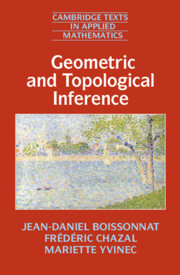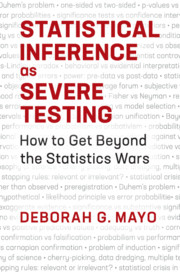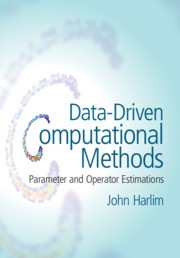Refine listing
Actions for selected content:
1437 results in Ebooks in machine learning
toc-group
- from Excursion 3 - Statistical Tests and Scientific Inference
-
- Book:
- Statistical Inference as Severe Testing
- Published online:
- 14 September 2018
- Print publication:
- 20 September 2018, pp 117-118
-
- Chapter
- Export citation
Tour II - How Not to Corrupt Power
- from Excursion 5 - Power and Severity
-
- Book:
- Statistical Inference as Severe Testing
- Published online:
- 14 September 2018
- Print publication:
- 20 September 2018, pp 353-370
-
- Chapter
- Export citation

Geometric and Topological Inference
-
- Published online:
- 14 September 2018
- Print publication:
- 27 September 2018

Statistical Inference as Severe Testing
- How to Get Beyond the Statistics Wars
-
- Published online:
- 14 September 2018
- Print publication:
- 20 September 2018
Frontmatter
-
- Book:
- Data-Driven Computational Methods
- Published online:
- 06 July 2018
- Print publication:
- 12 July 2018, pp i-iv
-
- Chapter
- Export citation
4 - Stochastic Spectral Methods
-
- Book:
- Data-Driven Computational Methods
- Published online:
- 06 July 2018
- Print publication:
- 12 July 2018, pp 60-79
-
- Chapter
- Export citation
3 - Ensemble Kalman Filters
-
- Book:
- Data-Driven Computational Methods
- Published online:
- 06 July 2018
- Print publication:
- 12 July 2018, pp 31-59
-
- Chapter
- Export citation
Appendix B - Stochastic Processes
-
- Book:
- Data-Driven Computational Methods
- Published online:
- 06 July 2018
- Print publication:
- 12 July 2018, pp 133-141
-
- Chapter
- Export citation
6 - Diffusion Forecast
-
- Book:
- Data-Driven Computational Methods
- Published online:
- 06 July 2018
- Print publication:
- 12 July 2018, pp 96-126
-
- Chapter
- Export citation
Dedication
-
- Book:
- Data-Driven Computational Methods
- Published online:
- 06 July 2018
- Print publication:
- 12 July 2018, pp v-vi
-
- Chapter
- Export citation
1 - Introduction
-
- Book:
- Data-Driven Computational Methods
- Published online:
- 06 July 2018
- Print publication:
- 12 July 2018, pp 1-15
-
- Chapter
- Export citation
5 - Karhunen–Loève Expansion
-
- Book:
- Data-Driven Computational Methods
- Published online:
- 06 July 2018
- Print publication:
- 12 July 2018, pp 80-95
-
- Chapter
- Export citation
Appendix C - Elementary Differential Geometry
-
- Book:
- Data-Driven Computational Methods
- Published online:
- 06 July 2018
- Print publication:
- 12 July 2018, pp 142-148
-
- Chapter
- Export citation
Preface
-
- Book:
- Data-Driven Computational Methods
- Published online:
- 06 July 2018
- Print publication:
- 12 July 2018, pp ix-xii
-
- Chapter
- Export citation
Contents
-
- Book:
- Data-Driven Computational Methods
- Published online:
- 06 July 2018
- Print publication:
- 12 July 2018, pp vii-viii
-
- Chapter
- Export citation
2 - Markov-Chain Monte Carlo
-
- Book:
- Data-Driven Computational Methods
- Published online:
- 06 July 2018
- Print publication:
- 12 July 2018, pp 16-30
-
- Chapter
- Export citation
References
-
- Book:
- Data-Driven Computational Methods
- Published online:
- 06 July 2018
- Print publication:
- 12 July 2018, pp 149-156
-
- Chapter
- Export citation
Appendix A - Elementary Probability Theory
-
- Book:
- Data-Driven Computational Methods
- Published online:
- 06 July 2018
- Print publication:
- 12 July 2018, pp 127-132
-
- Chapter
- Export citation
Index
-
- Book:
- Data-Driven Computational Methods
- Published online:
- 06 July 2018
- Print publication:
- 12 July 2018, pp 157-158
-
- Chapter
- Export citation

Data-Driven Computational Methods
- Parameter and Operator Estimations
-
- Published online:
- 06 July 2018
- Print publication:
- 12 July 2018
